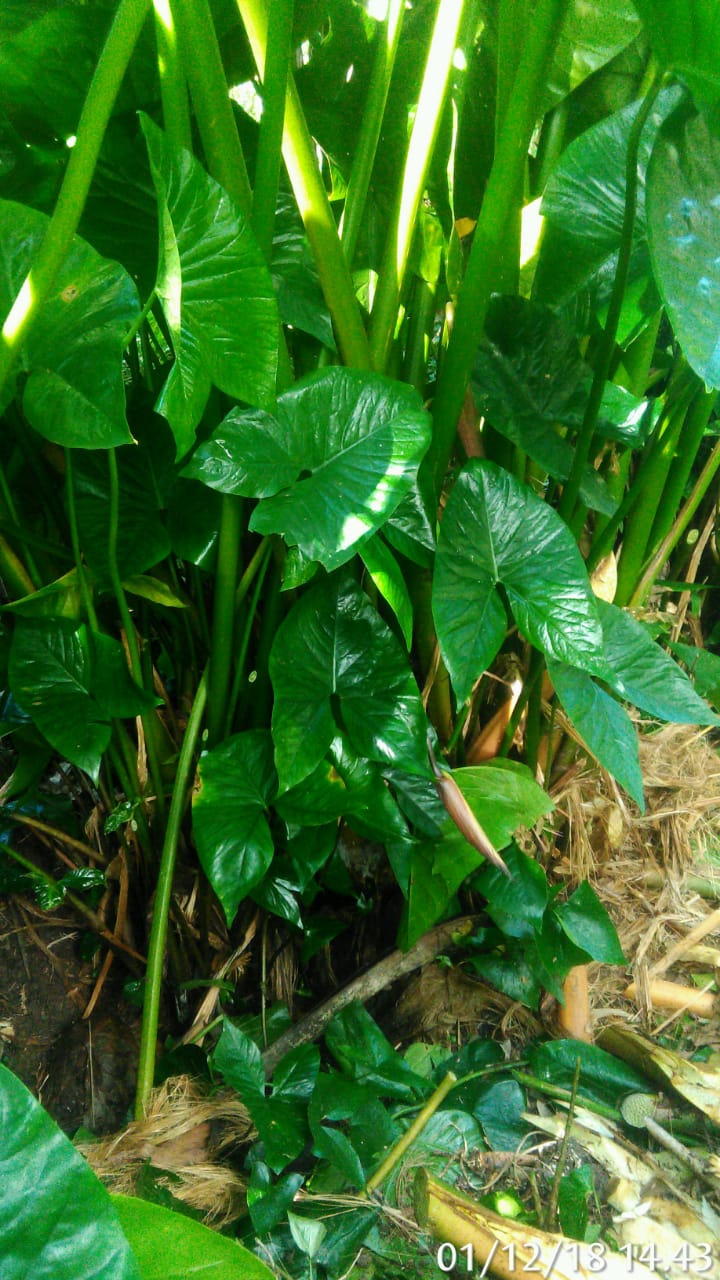
June 7, 2019, by Lexi Earl
Giant Swamp Taro: plant for the future?
Giant Swamp Taro (Cyrtosperma merkusii) is an underutilised but highly productive plant native to the North Sulawesi region of Indonesia. It can grow up to 5 metres tall, and may produce tubers underground that are 2 metres in diameter and up to 3 metres in length. It grows in flooded, brackish conditions. This makes it an excellent plant to grow in areas where the sea is spreading inland, altering the salinity of the soils. Farming in this region of Indonesia is characterised by smallholder farmers, working marginal lands, vulnerable to unpredictable and decreasing yields in the face of wider climatic changes out of their control. Rice, a current staple crop, is vulnerable to salinity and therefore the cultivation is affected by sea incursions. (Some islands in this region are only 14 metres above sea level, and are therefore experiencing changing conditions at a rapid rate.)
A new project, funded by a Newton Institutional Link with Indonesia brings together UK expertise in wetland soils, plants and crops, cropping and agro-economical systems, and rural socio-anthropology, with Indonesian expertise in biochemistry, plant physiology, market research, food technology, rural development and agricultural extension.
The goal of the project is to develop a food production model for giant swamp taro. At present, giant swamp taro is not consumed as a staple food within Indonesia because it is not currently grown as an agricultural crop. Little is known about giant swamp taro – there are no botanical descriptions, the genome has not been sequenced, and we do not know how flowers develop. Our basic understanding of where giant swamp taro grows, why it grows in particular places, and how it grows, are all missing.

However, there is much potential for the plant because it can be grown by small-scale farmers, even in conditions of climate change (due to its tolerance of salinity). Developing models for delivering food products from under-utilised/potential crops, such as giant swamp taro, will enable farmers to future-proof their livelihoods and food production in the face of harsher conditions and climates. Such crops can be grown sustainably, providing future foods that do not contribute to climate change.
The project focuses on a number of avenues in order to explore the full potential of giant swamp taro. The project will explore the growth habit and environmental tolerance of the giant swamp taro. The project will develop cultivation systems that allow the plant to be grown as a sustainable food source, including engaging directly with farmers to trial crop cultivations, and develop capacity in Indonesia. A key focus of the project is to increase food security in the local area, through exploring the use of these indigenous plants. The project will also, and possibly most importantly, develop options for marketable food products. This is important because it will impact on the sustainability of the crop for the farmers (by increasing their income), and will also allow the crop to be seen as a staple food within the community.
This project draws on researchers from multiple disciplines. It is led by Dr Sofie Sjögersten, Associate Professor in Environmental Science and includes Dr Guillermina Mendiondo (Crop Molecular Genetics, Future Food Beacon), Dr Scott Young (Environmental Science), Prof Debbie Sparkes (Agronomy), and Prof Paul Wilson (Agricultural Economics). The project will work with partners in Indonesia (including colleagues from the Catholic University of Delasalle working in agriculture, and Manado State University, working in biology), looking for solutions from the ground up, and contributes to the delivery of Indonesia’s Food Security Research Policy (2016-2019).
No comments yet, fill out a comment to be the first

Leave a Reply